CHAPTER 10
ADVANCED AND BRAIN-TYPE NUTRACEUTICALS
A PERSONALIZED, TARGETED APPROACH TO GETTING THE NUTRIENTS YOU NEED
If people “eat wild, fresh, organic, local, nongenetically modified food grown in virgin mineral- and nutrient-rich soils that has not been transported across vast distances and stored for months before being eaten . . . and work and live outside, breathe only fresh unpolluted air, drink only pure, clean water, sleep nine hours a night, move their bodies every day, and are free from chronic stressors and exposure to environmental toxins,” then it is possible that they might not need supplements. However, because people live in a fast-paced society where they pick up food on the fly, skip meals, eat sugar-laden treats, buy processed foods, and eat foods that have been chemically treated, most people could use a little help from a multiple vitamin/mineral supplement.
MARK HYMAN, MD, AS QUOTED IN THE BRAIN WARRIOR’S WAY
When I’m treating people, one question I always ask myself is What would I prescribe if this were my mother, my wife, or my child? More and more, after 35 years as a psychiatrist, I find myself recommending natural treatments. I am not opposed to medications and I have prescribed them for a long time, but I want you to use all of the tools available, especially if they are effective, less expensive, and have fewer side effects than medications.
My interest in nutraceuticals started after I began using brain SPECT imaging to help understand and treat my patients. One of the early lessons SPECT taught me was that some medications, especially those often prescribed for anxiety and pain, had a negative effect we could see on the scans. Later I learned some research suggested that a number of these medications increased the risk of dementia and strokes.[315] In medical school I was taught, “First, do no harm. Use the least toxic, most effective treatments.” As I looked for alternatives to these treatments to help the children and adults I was serving, I discovered that many natural supplements had strong scientific evidence behind them, with fewer side effects than prescription medications.
JENNIFER: MEDS MADE HER WORSE
One of the cases that got me interested in natural treatments involved my own niece. When Jennifer was seven, my sister brought her to see me for problems with moodiness and temper. I tried a number of medications for her without any success. My sister was calling me upset three times a week, and I kept using stronger and stronger medicines. But medications are not without risks and side effects, and when my niece started to gain weight, I took her off all of them and decided to try her on a group of natural supplements I had heard about from a colleague.
One day about four months later, I realized I hadn’t heard anything from my sister in a long time. I called her and said, “Hey, don’t you love me anymore? How’s my niece?”
She said, “Danny, you cannot believe the difference in her. She is so much better. She is calmer, more compliant, and she is getting straight As in school. Of course I love you.” The supplements have had long-term benefits for her without any side effects. Last year Jennifer graduated from law school.
WHAT YOU NEED TO KNOW ABOUT NUTRACEUTICALS
Supplements with medicine-like health benefits. That’s a simple way to think of nutraceuticals, a term that’s a combination of the words nutrient and pharmaceutical. Many of these natural products have been studied extensively and found to be effective. Other advantages: They can be less expensive than drugs, and insurance companies don’t need to be informed that you have taken them. This last point is key, since taking prescription medications may affect your insurability. I know many people who have been denied coverage or made to pay higher rates for health, life, disability, and long-term-care insurance because they have taken certain medications. If there are effective natural alternatives, it is worth considering them.
At Amen Clinics we have had success using combinations of nutraceuticals on patients with very damaged brains. In 2009, we started the world’s first and largest brain imaging study on active and retired NFL players. Many of them complained of problems with memory, mood, and focus and scored very poorly on the cognitive tests we gave them. As a group, their SPECT scans looked awful. For the treatment arm of the study, we used brain health education and targeted supplements, including a multivitamin/mineral complex, high-dose omega-3 fatty acids, ginkgo and vinpocetine for blood flow support, acetyl-L-carnitine for energy support, alpha-lipoic acid as an antioxidant and for blood sugar support, N-acetylcysteine as an antioxidant, huperzine A to support acetylcholine and memory, and phosphatidylserine for memory support. Our protocol demonstrated increased blood flow to multiple brain areas, including the prefrontal cortex and hippocampus, and improvements in memory, attention, and processing speed.[316]
BEFORE: 12 YEARS IN THE NFL
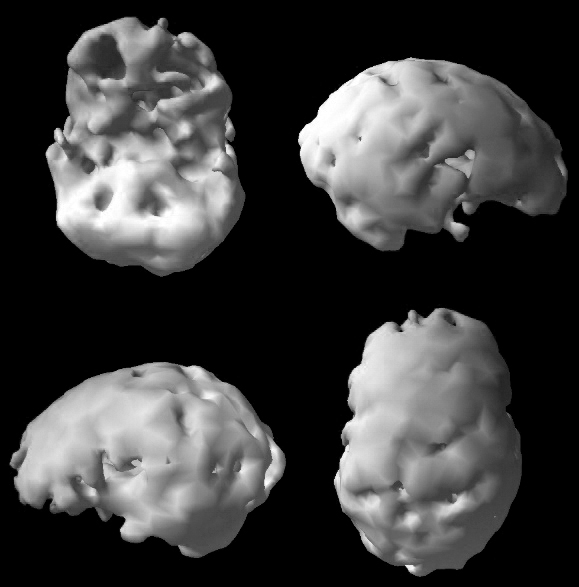
Severe overall decreased blood flow
AFTER 6 MONTHS ON NUTRACEUTICALS

Marked overall improvement
Nutraceuticals do have drawbacks. Although they tend to be less expensive than medications, you may pay more for them because insurance usually doesn’t cover their cost. What’s more, they are not completely without side effects, and they can interact with medications. “Natural” is not synonymous with “harmless”; both mercury and asbestos are natural, but both are dangerous to your health. St. John’s wort, one of my favorite natural antidepressants, can cause sun sensitivity, and it can also decrease the effectiveness of a number of medications, including birth control pills. (Just imagine: St. John’s wort has lifted your depression, but you also discover you are pregnant. You may not think this is the best timing.)
Quality control is an ongoing issue. Studies have shown that supplements don’t always contain what the label claims, which means they may not work or, alternatively, could be harmful. Don’t rely on the expertise of a health food store clerk for your supplement information. Instead, research brands online and develop a relationship with one or more, communicating your questions and issues to their technical and quality control staff.
Notwithstanding these issues, the benefits of nutraceuticals (and their relatively low risks compared to medications) make them worth considering, especially if you can get thoughtful, research-based information. I have witnessed targeted nutraceuticals make a positive difference in the lives of my patients, my family, and myself, which is why I take them every day and recommend them.
THREE NUTRACEUTICALS EVERYONE SHOULD TAKE
I typically recommend three nutraceuticals to all of my patients because they are critical to optimal brain function: a multivitamin/mineral, omega-3 fatty acids, and vitamin D.
1. A Multivitamin/Mineral
To feel better fast now and later, you need to give your brain the nutrition it requires. But there is evidence that many people are not getting it: More than 90 percent of Americans do not eat at least five servings of fruits and vegetables a day, the minimum required to get the nutrients you need, according to the Centers for Disease Control and Prevention (CDC).[317] An editorial in the Journal of the American Medical Association also asserted that most adults don’t get all the vitamins they need through diet alone and recommended a daily vitamin supplement for everyone because it helps prevent chronic illness.[318]
In the past 15 years, there have been more than 25 reports of mental health benefits from multivitamin/mineral formulas consisting of more than 20 minerals and vitamins.[319] In addition, studies show that multivitamin/mineral complexes can help with attentional issues,[320] mood,[321] and even aggression.[322] Two randomized, controlled trials were conducted after the 6.3-magnitude earthquake in February 2011 in Christchurch, New Zealand,[323] and the devastating flooding in southern Alberta, Canada, in June 2013.[324] Both trials showed reduced acute stress and anxiety scores in those taking a multivitamin/mineral. In the New Zealand earthquake study, the incidence of posttraumatic stress disorder (PTSD) decreased from 65 percent to 19 percent after one month of treatment, while the control group showed little improvement. These two trials suggest that multivitamin/mineral complexes could be an inexpensive public health intervention for normal populations following natural disasters.
A 2010 study tested the effects of taking a multivitamin versus a placebo on 215 men ages 30 to 55. After a month, the multivitamin group reported improved moods and showed better mental performance, as well as having a greater sense of vigor, less stress, and less mental fatigue after completing mental tasks —essentially making them both happier and smarter.[325] Another placebo-controlled study looked at the effects of multivitamins on 81 healthy children and found that those who took multivitamins performed better on two out of three attention tasks.[326]
2. Omega-3 Fatty Acids
Omega-3 fatty acids are essential to well-being, as we touched on in chapter 9. Low levels are one of the leading preventable causes of death, according to researchers at the Harvard School of Public Health.[327] Studies have shown that 95 percent of Americans do not get enough dietary omega-3 fatty acids. Low levels of EPA and DHA, two of the most important omega-3s, are associated with
- Inflammation[328]
- Heart disease[329]
- Depression and bipolar disorder[330]
- Suicidal behavior[331]
- ADHD[332]
- Cognitive impairment and dementia[333]
- Obesity[334]
Unfortunately, most people are low in EPA and DHA unless they are focused on eating fish (which can be high in mercury and other toxins) or they are taking an omega-3 supplement. We tested the omega-3 fatty acid levels of 50 consecutive patients not taking fish oil (the most commonly used source of EPA and DHA) who came into Amen Clinics and found that 49 had suboptimal levels. In another study, our research team correlated the SPECT scans of 166 patients with their EPA and DHA levels and found that those with the lowest levels had lower blood flow, the number one predictor of future brain problems, in the right hippocampus and posterior cingulate (one of the first areas to die in Alzheimer’s disease), among other areas.[335] On cognitive testing, we also found low omega-3s correlated with decreased scores in mood. Most adults should take between 1,000 and 2,000 milligrams of high-quality fish oil per day, balanced between EPA and DHA.
3. Vitamin D: Optimize Your Level
Its best-known roles may be in building bones and boosting the immune system, but vitamin D is also an essential vitamin for brain health, mood, and memory. Low levels have been associated with depression, autism, psychosis, Alzheimer’s disease, multiple sclerosis, heart disease, diabetes, cancer, and obesity. Seventy percent of the population is low in vitamin D because we are spending more time indoors and using more sunscreen (the vitamin is absorbed through the skin). It is easy to remedy a low level; get a blood test to check it, and if it is low (below 30 ng/mL), take between 2,000 and 10,000 IU a day. Recheck after two months to make sure your level is in the healthy range.

Take a daily multivitamin/mineral complex, 1,000–2,000 mg of fish oil balanced between EPA and DHA, and, if needed, vitamin D.
SUPPORT FOR YOUR MEMORY
Chapter 2 contains a discussion of the 11 risk factors that steal brain cells and contribute to memory loss, which I wrote about in my recent book, Memory Rescue. The risk factors are summarized in the words BRIGHT MINDS; each letter stands for one of the risks, from blood flow to toxins, mental health problems to sleep issues. Memory Rescue provides dozens of strategies to address each risk factor so that you can prevent cognitive impairment or get your memory back (see pages 38–44 for more). One of the strategies is to take specific nutraceuticals that address your BRIGHT MINDS issues. Here are some of those recommendations.
- Blood flow: ginkgo biloba, vinpocetine, green tea catechins, cocoa flavonols, resveratrol
- Retirement/Aging: phosphatidylserine, acetyl-L-carnitine, huperzine A
- Inflammation: omega-3 fatty acids, curcumins,[337] probiotics
- Genetics: curcumins, resveratrol, blueberry extract, green tea extract, vitamin D
- Head trauma support: omega-3 fatty acids
- Toxins: n-acetylcysteine, vitamin C, magnesium, pre- and probiotics
- Mental health: omega-3 fatty acids; also see the brain types, below
- Immunity/infections: vitamins C and D, aged garlic, Lion’s mane mushrooms, zinc
- Neurohormone deficiencies: zinc (testosterone), l-tyrosine (thyroid), DHEA, probiotics, ashwagandha (cortisol)
- Diabesity: chromium picolinate, berberine, cinnamon, alpha-lipoic acid
- Sleep: melatonin, magnesium, gamma-aminobutyric acid (GABA), 5-hydroxytryptophan (5-HTP) (if a worrier)
KNOW YOUR BRAIN TYPE AND SUPPORT IT WITH SUPPLEMENTS
Not all brains, even healthy ones, are the same. That’s a key lesson we have learned from our brain imaging work at Amen Clinics. When we first started to do SPECT scans in 1991, we were looking for the one pattern that was associated with anxiety, depression, addictions, bipolar disorder, obsessive-compulsive disorder, autism, or ADD/ADHD. But we soon discovered that no single brain pattern was associated with these illnesses; each one has multiple types that require their own unique treatments. It made sense that there would never be just one pattern for depression, for example, as not all depressed people are the same. Some are withdrawn, others are angry, and still others are anxious or obsessive. Taking a one-size-fits-all approach invites failure and frustration. Another lesson we learned is that symptom-guided treatment is often ineffective and harmful.
The scans helped us understand the type of anxiety, depression, ADHD, obesity, or addiction a person had, so we could better target treatment to individual brains. This one idea led to a dramatic breakthrough in our own personal effectiveness with patients, and it opened up a new world of understanding and hope for the tens of thousands of people who have come to see us and the millions of people who have read our books or seen our shows. In previously published books, I’ve written about seven types of ADHD, seven types of anxiety and depression, six types of addictions, and five types of overeaters. Understanding these types is critical to getting the right help. Here is a summary of five of the common brain types, along with recommended supplements for each one.
Brain Type 1: Balanced
People with this brain type tend to have healthy brains overall and be
- Focused
- Flexible
- Positive
- Relaxed
The SPECT scans of a balanced brain show full, even, symmetrical activity with no holes. The basic supplements just mentioned are the foundation for this type.
HEALTHY BRAIN SPECT SCAN
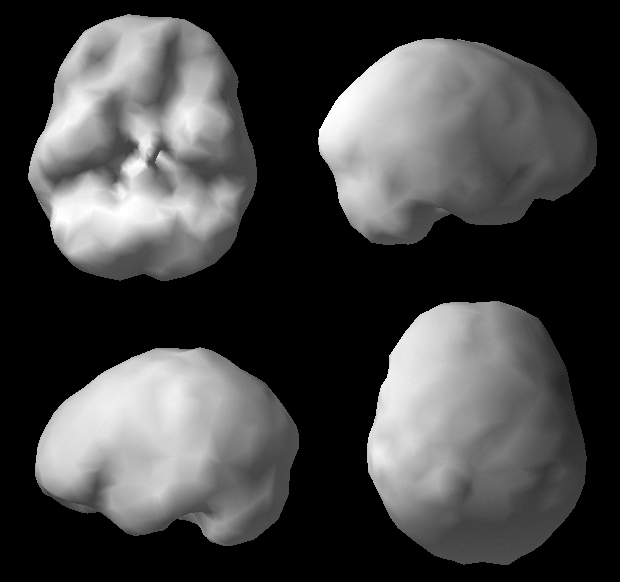
Full, even, symmetrical activity
Brain Type 2: Spontaneous
People with this brain type tend to be
- Spontaneous
- Risk-taking
- Creative, “out-of-the-box” thinkers
- Restless
- Easily distracted
- Unable to focus unless they are interested
The SPECT scans of this type typically show lower activity in the front of the brain in the PFC. The PFC functions as the brain’s brake (see chapter 3, page 53). It is the little voice in our heads that helps us decide between the banana and the banana split. The PFC stops us from saying or doing things that are not in our best interest, but it can also stop creative, out-of-the-box thinking. The Spontaneous Brain Type tends to be associated with lower dopamine levels in the brain and may cause people to be more restless, take more risks, and struggle to stay focused on something unless they are very interested in it. Our research team has published several studies showing that when people with this brain type try to concentrate, they actually have less activity in the PFC, which causes them to need excitement or stimulation in order to focus (think of firefighters and race car drivers).[338] Smokers and heavy coffee drinkers also tend to fit this type, as they use these substances to turn their brains on.
SPONTANEOUS BRAIN TYPE
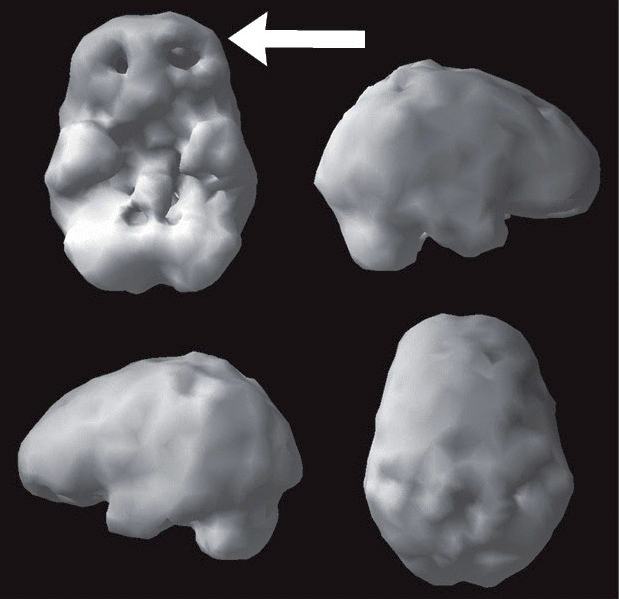
Low PFC activity at the front of the brain
Any supplement or medicine that calms the brain, such as 5-HTP or SSRIs (selective serotonin reuptake inhibitors), may make the Spontaneous Brain Type worse, as it will lower the already low PFC function, which can then take the brakes off your behavior. We have treated many people who had done things they later regretted, such as becoming hypersexual or spending money they did not have, when they were put on SSRIs. It turned out they had low activity in the PFC, and the serotonin-boosting medications diminished their judgment.
This brain type is best optimized by boosting dopamine levels to strengthen the PFC. Higher-protein, lower-carbohydrate diets tend to help, as do physical exercise and certain stimulating supplements, such as rhodiola, green tea extract, L-theanine, ashwagandha, panax ginseng, ginkgo biloba, and phosphatidylserine. Try them in the order listed here for a few days each to see which work best for you. If one or more overstimulates or upsets you, stop taking it and move on to the next in the list.
- Rhodiola, an herb that is grown at high altitudes in Asia and Europe, has been traditionally used to fight fatigue, improve memory, and increase attention span. It is called an adaptogen because it helps the body adapt to stress and assists in bringing our body processes back to normal. In an Amen Clinics study we conducted with scientist Mahtab Jafari, PhD, from the University of California, Irvine, we found that rhodiola helped to increase blood flow to the brain, especially the prefrontal cortex. Our study group also reported better mood and energy. Look for Rhodiola rosea root standardized to contain 3 percent rosavins and a minimum of one percent salidrosides. The typical adult dose is 170–200 mg twice a day.
- Green tea extract is made from the dried leaves of Camellia sinensis, an evergreen shrub. It has been used to improve focus; as a remedy for many ailments, including anxiety; and to assist with weight loss. The green tea component epigallocatechin gallate (EGCG) is a potent free-radical scavenger. The typical daily adult dose is 200–300 mg. Up to three cups of green tea can be consumed daily instead of a supplement, but pregnant women should use caution as green tea contains caffeine.
- L-theanine is an amino acid uniquely found in green tea. It crosses the blood brain barrier and can increase dopamine. It also increases GABA and serotonin, so it tends to have a balancing effect on the brain. It helps with focus as well as mental and physical stress. The typical dose is 100–200 mg two to three times a day.
- Ashwagandha (Withania somnifera, Indian ginseng, Indian winter cherry) is a shrub found in India, Nepal, and Pakistan that is commonly used to help focus and relaxation. The plant itself is an adaptogen, with properties that enable the body to better handle stress, anxiety, and fatigue. It helps to rejuvenate and energize the nervous system and increase physical endurance. It also has antioxidant, anti-inflammatory, and antiaging effects. It is well tolerated; few adverse effects have been reported. Those who take medications for thyroid issues, hypertension, or diabetes should exercise caution, as ashwagandha may stimulate thyroid function, cause a decrease in blood pressure, or lower blood sugar. The recommended dose is 125 mg twice a day.
- Panax ginseng is a plant with fleshy roots that typically grows in cooler climates, including the northern regions of eastern Asia, Korea, and Russia. Ginseng is most widely known as a stimulant that promotes energy, improves circulation, and increases blood supply. For these reasons it has been used to improve cognitive and physical performance during endurance exercise. The typical adult dose is 200 mg twice a day.
- Ginkgo biloba is a powerful nutraceutical from the Chinese ginkgo tree that enhances circulation, memory, and concentration. The most studied form of ginkgo biloba is an extract called EGb 761, which has been studied in blood-vessel disease, clotting disorders, depression, and Alzheimer’s disease. In a 2003 double-blind, placebo-controlled study using SPECT, Brazilian researchers studied 48 men between the ages of 60 and 70 for eight months and found significant improvements in blood flow and global cognitive functioning among those taking gingko. The placebo group showed the opposite, with decreased brain blood flow and poorer scores on cognitive testing.[339] Consider taking ginkgo if you suffer from low energy or have trouble concentrating. There is a small risk of internal bleeding, so if you are taking any other blood-thinning agents, the dosages may need to be reduced. The typical adult dose is 60–120 mg twice daily.
- Phosphatidylserine (PS) is a naturally occurring nutrient found in foods such as fish, green leafy vegetables, soy products, and rice. PS is a component of cell membranes, which change in composition as we age. It is essential to brain health, as it maintains neurons and neuronal networks so that the brain can continue to form and retain memories. Reportedly, taking PS may help improve age-related declines in memory, learning, verbal skills, and concentration. Research done with positron emission tomography (PET) studies, similar to SPECT, on patients who have taken PS show that it produces a general increase in metabolic activity in the brain.[340] The typical adult dose is 100–300 mg a day.
Brain Type 3: Persistent
People with this brain type tend to
- Be persistent
- Be relentless or strong-willed
- Like things a certain way
- Get “stuck” on thoughts
- Hold on to hurts
- See what is wrong in themselves or others
Take-charge people who won’t take no for an answer are likely to have this brain type. They tend to be tenacious and stubborn. In addition, they may worry, have trouble sleeping, be argumentative and oppositional, and hold grudges from the past. The Persistent Brain Type often has increased activity in the front part of the brain, in an area called the anterior cingulate gyrus (ACG) —what I have described previously as the brain’s gear shifter. It helps people go from thought to thought or move from action to action, and it is involved with being mentally flexible and going with the flow. When the ACG is overactive, usually due to low levels of serotonin, people can have problems shifting attention, which can make them persist —even when it may not be a good idea for them to do so. Caffeine and diet pills tend to make this brain type worse because they stimulate brains that do not need more stimulation. Indeed, people who have a Persistent Brain Type may feel as though they need a glass of wine at night, or two or three, to calm their worries.
NORMAL “ACTIVE” BRAIN SPECT SCAN
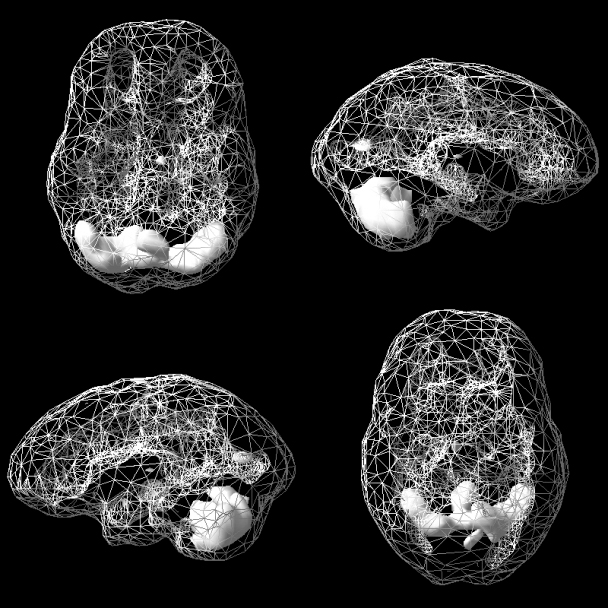
Most active areas in the cerebellum at the back of the brain
PERSISTENT BRAIN TYPE
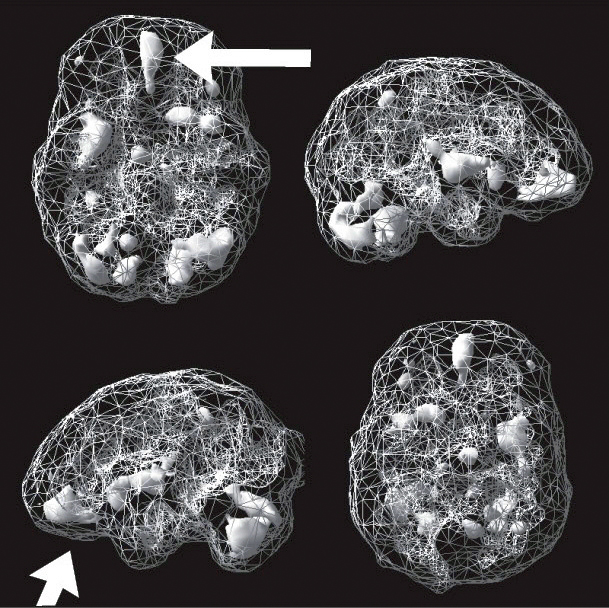
High ACG activity at the front of the brain
High-glycemic carbohydrates like bread, pasta, and sweets turn to sugar quickly and increase serotonin, which is calming to the brain. That’s why Persistent Brain Types can become addicted to these simple carbohydrates. They often use carbs as “mood foods” to self-medicate an underlying mood issue. It is best to avoid these quick fixes because they can cause long-term health problems. (See chapter 9, “To Boost Mood,” page 225, for healthy food choices that will drive serotonin into the brain.) Instead, use physical exercise to boost serotonin, and consider taking supplements such as L-tryptophan, 5-HTP, and saffron.
- L-tryptophan is a naturally occurring amino acid and building block for serotonin that is particularly abundant in milk, meat, and eggs. With my patients, I have found that it helps to decrease stress[341] and aggressiveness;[342] improve sleep, cognitive flexibility, and mood;[343] and foster a positive mind-set in females.[344] One of the problems with dietary L-tryptophan is that a significant portion of it does not enter the brain. Instead, much of what we consume is used to make proteins and vitamin B3. This necessitates taking large amounts of L-tryptophan —I recommend a dose of 1,000–3,000 mg a day for adults. Take it on an empty stomach because other amino acids in proteins can block its absorption and its entry into the brain.
- 5-HTP, another amino acid, is a step further along in the serotonin production pathway. It is more widely available than L-tryptophan and more easily taken up in the brain —70 percent versus 3 percent of L-tryptophan. About 5 to 10 times more powerful than L-tryptophan, 5-HTP boosts serotonin levels in the brain and helps to calm ACG hyperactivity (greasing the cingulate, if you will, to improve shifting one’s attention). A number of double-blind studies have shown that it is also an effective mood enhancer[345] and appetite suppressor.[346] The recommended adult dose of 5-HTP is 50–300 mg a day. Children should start with a half dose. As with L-tryptophan, it is best to take 5-HTP on an empty stomach to help with absorption. The most common side effect is an upset stomach, which is usually very mild. Start with a low dose and work your way up slowly.
- Saffron, one of the world’s most expensive spices, is grown mostly in Iran, Greece, Spain, and Italy and traditionally has been consumed to help digest spicy food and soothe an irritated stomach. It also has been used for hundreds of years as a folk medicine for a variety of health problems. In recent years there has been significant research showing that saffron can help boost serotonin and benefit mood,[347] memory,[348] and sexual function;[349] decrease the symptoms of PMS;[350] and, when combined with methadone, help alleviate withdrawal symptoms in patients undergoing treatment for opioid addiction.[351] The recommended adult dosage is 15 mg twice a day.
Brain Type 4: Sensitive
People with this brain type tend to
- Be sensitive
- Feel deeply
- Be empathic
- Struggle with moods
- Be more pessimistic
- Struggle with negative thoughts
The SPECT scans of the Sensitive Brain Type tend to show increased activity in the limbic or emotional centers of the brain, making these people empathic and deeply feeling but also subject to issues with their moods. They may also struggle with being more pessimistic and having negative thoughts.
NORMAL “ACTIVE” BRAIN SPECT SCAN

Most active areas in the cerebellum at the back of the brain
SENSITIVE BRAIN TYPE
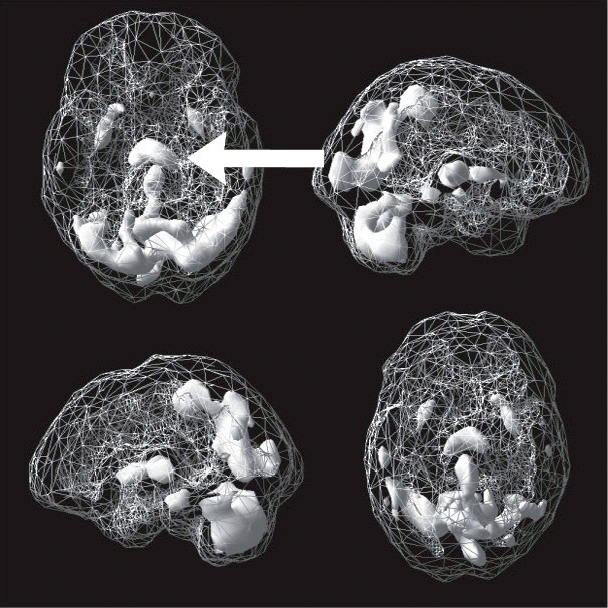
High deep limbic activity (arrow)
Exercise, omega-3 fatty acids (1,000–2,000 mg a day), vitamin D, and a nutraceutical known as s-adenosyl-methionine (SAMe) may help the Sensitive Brain Type. If someone with this type is also a Persistent Brain Type (yes, it’s possible to be a combination of types), the supplements or medications that boost serotonin may help the most.
- SAMe is crucial for the production of several neurotransmitters (dopamine, epinephrine, and serotonin)[352] and in gene regulation, and it has additional, very important actions that allow the brain to function properly. The brain normally manufactures all the SAMe it needs from the amino acid methionine. When someone is depressed, the synthesis of SAMe from methionine is impaired; taking SAMe has been shown to have antidepressant qualities. A 2017 comprehensive review by the American Psychiatric Association Council on Research Work Group found SAMe a promising treatment for depression.[353] SAMe has also been found to reduce joint inflammation and pain. People who have a tendency toward bipolar disorder should check with their doctor before trying this supplement. The typical adult dose is 200–400 mg two to four times a day. Usually it is best taken early in the day as it may be more stimulating for some. SAMe has been found to enhance mood more effectively if taken with 250 or 375 mg a day of trimethylglycine (TMG, betaine).[354]
Brain Type 5: Cautious
People with this brain type tend to be
- Cautious
- Prepared
- Motivated
- Reserved
- Busy-minded
- Restless
On SPECT images, we often see heightened activity in the anxiety centers of the brain, such as the basal ganglia, insular cortex, or amygdala. The neurotransmitter GABA helps calm overfiring in the brain, and low levels of GABA frequently cause people with this brain type to struggle more with anxiety and subsequently be more cautious and reserved. On the flip side, they also tend to be more prepared.
NORMAL “ACTIVE” BRAIN SPECT SCAN

Most active areas in the cerebellum at the back of the brain
CAUTIOUS BRAIN TYPE

High basal ganglia activity (arrows)
Meditation and hypnosis can help soothe this brain type (see chapter 1, pages 11–20), as can a combination of vitamin B6 (25 mg); magnesium glycinate, magnesium malate, or magnesium citrate (the forms of magnesium that are best absorbed by the body; take 150–300 mg two to three times a day); and GABA, the calming neurotransmitter (250–750 mg two to three times a day).
It is common to have more than one brain type, and when we look at all of the potential combinations, it adds up to 16 types, such as Spontaneous-Persistent-Sensitive or Sensitive-Cautious. Many years ago we realized that not everyone can come to one of our clinics to get scanned, so based on thousands of scans, we’ve developed a questionnaire that helps predict what yours might look like. The questionnaire is not as effective as actually looking at the brain, but it is still helpful and used by thousands of medical and mental health professionals around the world.

You can find out your brain type as part of our free Brain Health Assessment on www.brainhealthassessment.com, where we also have specific suggestions to help each type.
Nutraceuticals can have a powerful effect on your brain health, often without the side effects that medications can have. Start with a multivitamin/mineral, omega-3 fatty acid supplement, and vitamin D if needed. Then try adding one supplement at a time, based on your primary symptoms and brain type, and see what helps you to feel better.
FOUR STRATEGIES TO USE NUTRACEUTICALS TO FEEL BETTER FAST
- Take a multivitamin/mineral, omega-3 fatty acids, and vitamin D if your levels are low.
- Find out if any medications you are taking might be depleting your body of essential nutrients and, if so, consider supplementing the shortfall.
- Know your risks of memory loss and supplement to prevent cognitive impairment.
- Find out which of the five basic brain types you have at www.brainhealthassessment.com, and try different supplements to improve your brain’s healthy function.
TINY HABITS THAT CAN HELP YOU FEEL BETTER FAST—AND LEAD TO BIG CHANGES

Each of these habits takes just a few minutes. They are anchored to something you do (or think or feel) so that they are more likely to become automatic. Once you do the behaviors you want, find a way to make yourself feel good about them—draw a happy face, pump your fist, or do whatever feels natural. Emotion helps the brain to remember.
- When I eat my breakfast, I will take a multivitamin/mineral and omega-3 fatty acid supplement. I will also know my vitamin D level and take extra if needed.
- If I take medication, I will also take specific supplements to replenish any essential nutrients the prescription may be depleting (see chart on page 234).
- On Sunday mornings I will refill my supplement organizer.